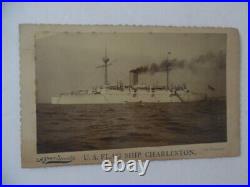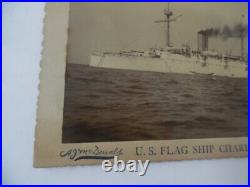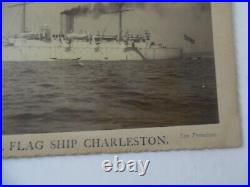






This is an original antique boudoir card photo of the USS Charleston by the photographer A. McDonald of San Francisco, California. This photo is on the original mount which has scalloped edges and measures about 8.5″ x 5.25″ and is printed U. McDonald and San Francisco marks also on the mount. The verso has a stamp from G. Beach Bookseller and Stationer of San Francisco. The USS Charleston (C-2) was a US Navy Protected Cruiser launched in July 1888 and wrecked after ground on an uncharted reef in the Philippines in November 1899. USS Charleston was flagship of both the US Navy Pacific Squadron and the US Navy Asiatic Squadron. The following is some information on the USS Charleston (C-2) from Wikipedia. The second USS Charleston (C-2) was a United States Navy protected cruiser – the fourth US protected cruiser to be built. Of Newcastle, the construction to be by an American shipyard. In design, she succeeded the “ABC” cruisers Atlanta, Boston, and Chicago with better protection, higher speed, and similar armament. She was launched on 19 July 1888 by Union Iron Works, San Francisco, California, sponsored by Mrs. Smith, and commissioned on 26 December 1889, Captain George C. USS Baltimore was also built to Armstrong plans. Building Charleston’s propulsion machinery proved troublesome; apparently it was a combination of components of several different plants. Charleston was armed with two 8-inch (203 mm)/35 caliber Mark 3 guns, one each in bow and stern barbettes, and six 6-inch (152 mm)/30 caliber Mark 3 guns[5] in sponsons along the sides. The 8-inch guns were initially unavailable, so from her commissioning in 1889 until a refit in 1891 they were replaced by four additional 6-inch guns. [2][4] Secondary armament was four 6-pounder 2.2 in (57 mm) guns, two 3-pounder 1.85 in (47 mm) Hotchkiss revolving cannon, two 1-pounder 1.5 in (37 mm) Hotchkiss revolving cannon, and two. 45 caliber (11.4 mm) Gatling guns. [1][4] Four 14-inch (356 mm) torpedo tubes were included in the design but never mounted. Charleston had 3 in (76 mm) gun shields, 2 in (51 mm) barbettes, and a 2 in (51 mm) conning tower. The complete armored deck was up to 3 in (76 mm) on its sloped sides and 2 in (51 mm) in the middle. The engineering plant included six coal-fired cylindrical boilers producing steam for two horizontal compound engines totaling 7,500 ihp (5,600 kW) for a speed of 18.2 knots (33.7 km/h; 20.9 mph) on trials. Unlike some contemporary designs, no sails were fitted. Charleston carried 328 tons of coal for a range of 2,990 nmi (5,540 km; 3,440 mi) at 10 kn (19 km/h; 12 mph); this could be increased to 682 tons for 7,477 nmi (13,847 km; 8,604 mi). Charleston cleared Mare Island Navy Yard on 10 April 1890 to join the Pacific Squadron as flagship, cruising in the eastern Pacific. Between 19 August and 31 December 1891, Charleston cruised in the Far East as flagship of the Asiatic Squadron, rejoining the Pacific Squadron in 1892 until 7 October, when she departed for the east coast, calling at a number of South American ports en route. Charleston arrived in Hampton Roads on 23 February 1893. Taking the review was President Grover Cleveland in despatch vessel USS Dolphin. After a leisurely cruise from Montevideo, Uruguay, she arrived in San Francisco on 8 July 1894 to prepare for a return to the Asiatic Station. She cruised in the Far East until 6 June 1896, when she steamed from Yokohama for San Francisco where she was placed out of commission on 27 July 1896. Upon the outbreak of the Spanish-American War, Charleston was quickly made ready for service, and was recommissioned on 5 May 1898, Captain Henry Glass, Commanding. Sixteen days later, she sailed for Honolulu, where she was joined by three chartered steamers transporting troops, [3] including City of Peking. Charleston was sent to raise the American flag over Guam, then a Spanish possession. At daybreak on 20 June, the little convoy arrived off the north end of Guam. Charleston investigated the harbor at Agana, then proceeded to Apra Harbor. Leaving the transports safely anchored outside, Charleston sailed boldly into the harbor, firing a challenge at Fort Santa Cruz. Almost at once, a boatload of Spanish authorities came out to apologize for having no gunpowder with which to return the presumed salute. The next day the surrender was received by a landing party sent ashore from Charleston. With the Spanish governor and the island’s garrison of 69 as prisoners in one of the transports, Charleston then sailed to join Admiral George Dewey’s fleet in Manila Bay. She arrived Manila on 30 June 1898 to reinforce the victors of the previous month’s great naval battle in their close blockade of the Bay. Charleston joined in the final bombardment of 13 August, which brought about the surrender of the city of Manila. She remained in the Philippines through 1898 and 1899, bombarding insurgent positions to aid Army forces advancing ashore, and taking part in the naval expedition that captured Subic Bay in September 1899. Loss by wrecking, November 1899. Charleston grounded on an uncharted reef near Camiguin Island north of Luzon on 2 November 1899. On 12 November, gunboat Helena (PG-9) arrived to rescue the shipwrecked men. If you have questions about how to pay for this item please let me know. This item is in the category “Collectibles\Transportation\Boats & Ships\Military\Photographs”. The seller is “timomills” and is located in this country: US. This item can be shipped worldwide.
- Country/Region of Manufacture: United States

